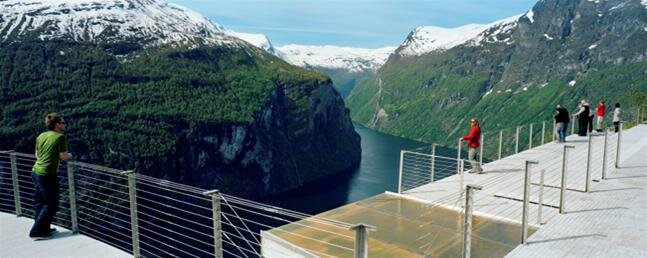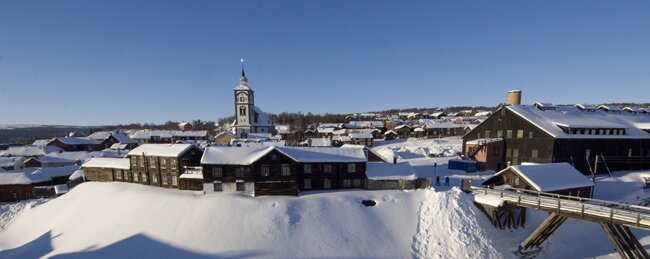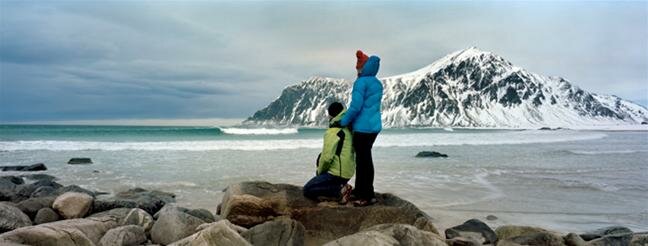The west coast
Few places in the world offer such magnificent scenery as the fjords of western Norway. Many of them are deep and narrow, with mountains rising sheer out of the water and waterfalls cascading from great heights. But you will also find more open, “friendly” fjords, where rich farmland and fisheries have created prosperous communities.
The diversity of the Norwegian fjords is also visible in other ways. In the summer, you can start your day skiing on the Folgefonna glacier and end it swimming in the sea. There are places where blossoming fruit trees meet snow-capped mountains. You can experience the art of nature in the waterfall known as the Bridal Veil together with the art of engineering in the hairpin bends of the Ørneveien or Trollstigen roads. You can also look forward to visiting the towns of Bergen and Stavanger, where charming wooden houses and a modern shipping and petroleum industry exist side by side.
More information about the fjords, the Stavanger region or Bergen at visitnorway.com - the official travel guide to Norway.
 Viewpoint Geirangerfjord. Photo: CH / Innovation Norway
Viewpoint Geirangerfjord. Photo: CH / Innovation Norway
Central Norway
Central Norway has played a key role in Norway’s history. The battle fought at Stiklestad in 1030 was a turning point for the Christianisation of the country. Nidaros, the original name for Trondheim, was the political, religious and commercial centre of the country and a destination for pilgrims for more than four centuries during the Middle Ages.
Nidaros Cathedral is the largest medieval structure in Scandinavia, and boasts some magnificent sculptures and beautiful stained-glass windows. The original church was built on the place where St. Olav was buried after his death at the Battle of Stiklestad.
Trondheim is noted for its wooden buildings, and many of the oldest line the harbour and the river, testifying to the city’s long commercial history.
To the east lies the very well-preserved mining town of Røros. The town, with its unique church and some hundred beautiful wooden houses, is on UNESCO’s World Heritage List.
Read more about the coast of Trøndelag, Røros or Trondheim.
 The church in Røros. Photo: Terje Rakke / Nordic Life AS / Innovation Norway
The church in Røros. Photo: Terje Rakke / Nordic Life AS / Innovation Norway
Northern Norway
In northern Norway, the midnight sun sheds its clear light on dramatic island formations, deep fjords, snow-capped mountains, lush pastures and vast moors. The magical quality of the light in this region has inspired many a writer, musician and artist.
This magnificent region has a lot to offer. Whether you choose to travel along the coast on a Coastal Steamer or follow the roads, you will come across charming villages and old trading posts where you can get acquainted with the local people and culture. You can meet the Saami, the indigenous people of the north, and learn about their traditions and how they live today.
In spite of its northerly latitude, northern Norway enjoys a mild climate thanks to the temperate waters of the Gulf Stream, which hugs the coast. If you want to sample nightlife as well as culture, the town of Tromsø is often called “the Paris of the North” – or you can visit the North Cape and experience the view from the very edge of Europe.
Learn more about the Lofoten islands, Finnmark or the city of Tromsø.
 Couple at Ramberg beach, Lofoten . Photo: CH / Innovation Norway
Couple at Ramberg beach, Lofoten . Photo: CH / Innovation Norway
Southern Norway
In addition to good, stable summer weather, this region offers everything from charming coastal resorts teeming with life to the outstanding scenery and cultural activities of the inland areas. Small towns and villages are strung out along the coast like pearls on a string, often well protected by the rocky offshore islands.
Good, safe harbours were important for the trading ships and fishing boats of yore, and these maritime havens gradually developed into vital commercial and cultural centres. In the summer, local markets overflow with fruit, berries and choice vegetables, and of course fresh fish. Unless, of course, you prefer to catch it yourself.
Waiting inland, though not far from the coast, are mountains and valleys, lakes for freshwater fishing, tranquil forests and upland moors. As all downhill enthusiasts know, the cradle of skiing is Morgedal in the county of Telemark. But not far away you can sail from the coast into the far reaches of the countryside along the Telemark Canal aboard the venerable Victoria. The canal has won Europa Nostra’s highest award for restoration and preservation.
Read more about southern Norway or the Kristiansand region at visitnorway.com - the official travel guide to Norway.
 Lyngør on the coast of Southern Norway. Photo: Matti Bernitz / Innovation Norway
Lyngør on the coast of Southern Norway. Photo: Matti Bernitz / Innovation Norway
Eastern Norway
Eastern Norway boasts a varied landscape ranging from flat, rolling farmland to dramatic, towering mountains. It is in this region that you’ll find the capital, Oslo, as well as Norway’s oldest town, Tønsberg, Norway’s largest lake, Lake Mjøsa, and Norway’s highest mountain, Galdhøpiggen (2469 metres).
Eastern Norway is Norway’s most densely populated region and offers a rich selection of cultural activities and outdoor pursuits. Large parts of the region are covered in forest and a myriad of lakes and rivers offer excellent fishing prospects. An absolutely unique cultural and architectural experience is a visit to the almost 1000-year-old cathedral ruins at Hamar on Lake Mjøsa.
Situated at the head of the Oslo fjord is the capital, with its large and varied programme of concerts, theatre and opera, museums and galleries. Oslo is also known for its nightlife, informal street cafés, varied choice of restaurants and wide selection of shops.
Just a short distance from Oslo lie the beautiful meandering valleys of Numedal, Hallingdal, Eggedal and Gudbrandsdalen. Also within easy reach are sweeping landscapes, picturesque coastal villages and large, unspoilt mountain areas.
More information about Oslo or the Jotunheimen mountains.
 Galdhøpiggen. Photo: Johan Wildhagen / Innovation Norway
Galdhøpiggen. Photo: Johan Wildhagen / Innovation Norway